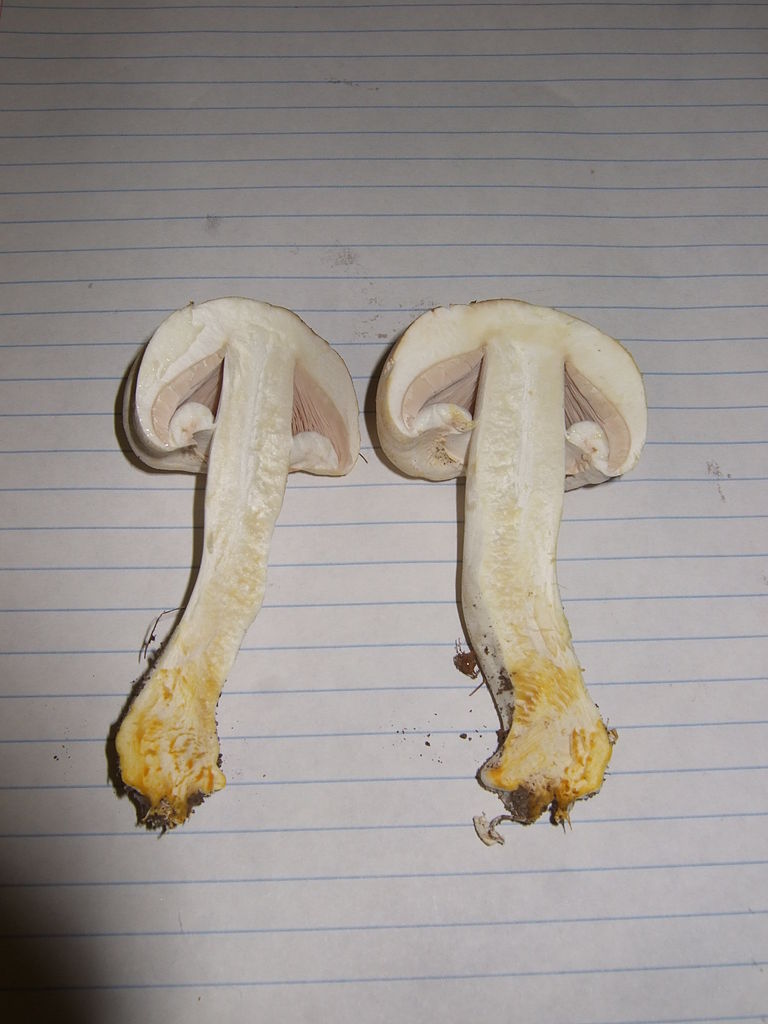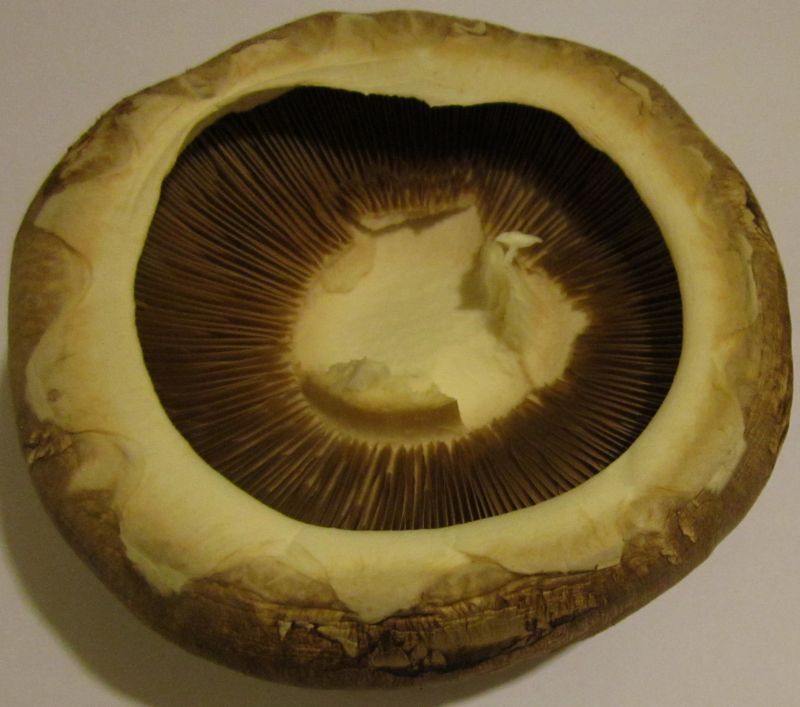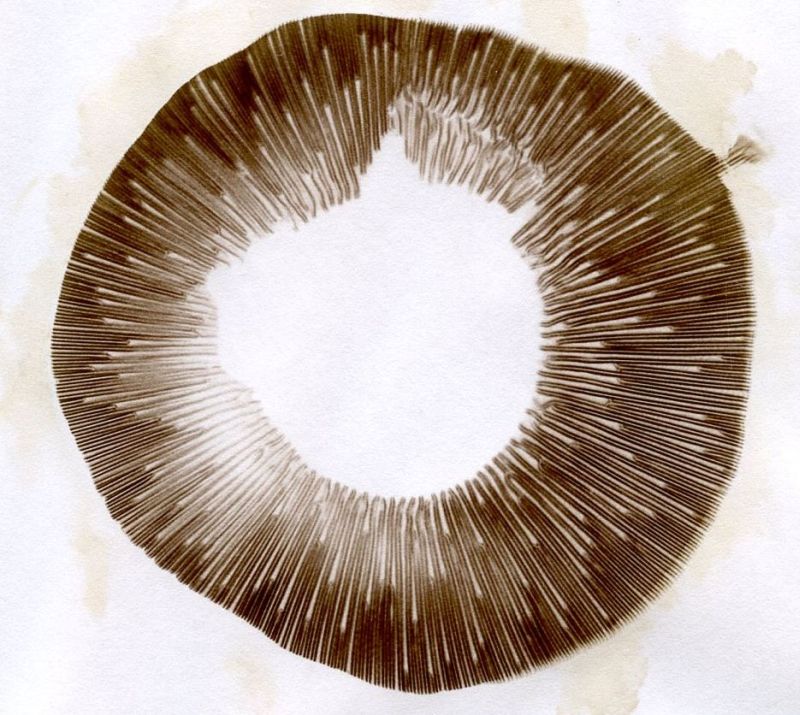Nature's Restaurant:
Fields, Forests & Wetlands Foods of Eastern North America
A Complete Wild Food Guide
Search Nature's Restaurant & Wild Foods Home Garden Websites:
Common Mushroom - Agaricus bisporus
Season: Late Spring to Fall
Common Mushroom (Agaricus bisporus). By: Jerzy Opioła Attribution-Share Alike 3.0 Unported
READ THIS Before Gathering and Eating Wild Mushrooms.
Urban, Rural or Both: Rural mainly
Common Mushroom (Agaricus bisporus). There are a few other common names the Common Mushroom has: Button mushroom, Portobello, Portabella, Portabello, White mushroom, Table mushroom, Cultivated mushroom, Champignon mushroom, Cremini/Crimini mushroom, Brown cap mushrooms, Italian mushroom, Italian brown, Roman brown mushroom, Swiss brown mushroom, chestnut mushroom, Portabellini, Baby Portobello, Baby Bella and Mini Bella. I wonder if I've missed any? It also has two other Latin names: the Agaricus brunnescens, and for the white version only, the Agaricus hortensis.
Yes, this is the "grocery store" mushroom. It is native to Europe and North America, and you can find it and harvest it yourself. I'm going to tell you something about it they never seem to advertise on the label or in the store for some odd reason: it grows out of poop. I think the real name should be the "manure mushroom". If you want wild ones, you need to find a grassy field where there is ample dung from grazing animals. They pop up after a rain, so the day after a good rain is a good time if you know where there is a manure covered grassy field you have permission to collect on.
Now, I know a lot of people will wonder how the "Button mushroom" you buy in a store could be the exact same mushroom as the Portobello. For one thing, the Button mushroom is picked at a very immature stage of the mushroom's cycle - known as the button stage, hence the name "Button mushroom". The Portobello is picked when the mushroom is at the fully mature stage. The color difference on the cap (white or brown) is just due to variations within the species. In the wild, you are far, far more likely to find the brown cap variety. The white ones you buy in a store all came from a source of white ones found by accident many decades ago.
In the wild, don't pick them at the button stage, as that is when you can easily mistake it for the deadly Amanita - the Destroying Angel. Stick to mature specimens, where you can clearly see the chocolate brown gills (sometimes with a pinkish hue) - BUT NOT WHITE. You need to take a spore print, and it must dark chocolate brown. Also, when picking, take some of the stem out of the ground and make sure there is not a ball like or cup like base. See the section on the Destroying Angel to learn more. You must be able to identify a Destroying Angel before you attempt foraging for this mushroom.
When gathering, cut a chunk out of the base of the stem of each one. Does it turn yellow? If so, it is probably an Agaricus xanthodermus. It won't kill you, but you will feel very sick after eating this one.
It is a mushroom that can be eaten raw, but because it grows close to, or right from where there is poop, I like to cook it. Call me cautious.
Growing this Mushroom:
For introductory growing instructions, go to my Wild Foods Home Garden website Common Mushroom page.
Description:
- Cap Morphology: Depends on stage. Flattened spherical when a button, to convex when mature, to flat when very mature. Can be white or light brown, light brown is the most common. Generally ranges from 3-16 cm (1 1/5 to 6 1/3 inches) across. Flesh on cap is thick and white.
- Spore Bearing Surface: Gills on the underside of the cap. Pink to pale brown when mushroom is immature, turning to brown when mature to very dark brown when very mature.
- Gill Attachment (how the Spore Bearing Surface is attached to the Stipe or Stem): Free - not attached to stem when mushroom mature.
- Spore print: Chocolate brown
- Stipe (Stalk): Has an annulus (ring). Stem is 2-8 cm (4/5 to 3 inches) long and 1-3 cm (2/5 to 1 1/5 inches) thick.
- Partial Veil: Yes, button size mushrooms have veil present (therefore you cannot see gills). Once the mushroom is mature, veil is gone.
- Season: Late spring to fall.
- Habitat: A few to a huge number on compost or manure. Most commonly found in the grocery store, but in the wild best to look in grassy areas where animals are grazing and leaving their manure.
- Notes: This is the most commonly grown mushroom in the world.
- Recipe search on the web here (Google search) and here (Bing search).
- Pictures on the web here (Google images) and here (Bing images).
![]()
Gill Attachment (how the Spore Bearing Surface is attached to the Stipe or Stem): Free - the gills do not touch the stem. By: Debivort GNU Free Documentation License, Version 1.2


Cap Morphology: Convex to flat. By: Debivort GNU Free Documentation License, Version 1.2

Agaricus bisporus. Cap is convex to flat. The gills are free (don't touch the stem). Often there is a ring on the stem a little down the stem under the gills, and you can see it clearly here.

Agaricus bisporus. This is a close-up of where the gills meet (or don't in this case) the stem. When they don't attach directly to the stem like in all three of the edible Agaricus I've listed (Field Mushroom, Horse Mushroom, and this one), this is called "free", as in, free of the stem.

(Agaricus bisporus). This shows how the "free" gills look when you turn an Agaricus over. Take note of how some gills extend from the edge of the cap all the way to right by the stem, while some don't make it a third or half way. The ones that don't make it are "short" gills. This is typical of an Agaricus.

Common Mushroom (Agaricus bisporus) - the most commonly bought grocery store mushroom. The white color is just a mutant genetic fluke discovered by a Pennsylvania mushroom farmer in 1926. People liked it, and it caught on and became the normal. Also, the name buttom mushroom comes from the mushroom being picked immature - before the cap opens up. In mushroom terminology, this is called the "button" stage. By: Мыць Денис - a Public Domain image.

Common Mushroom (Agaricus bisporus). This is the more common color this mushroom would be found in the wild. Still picked and used in the button stage. By: wikioticsIan Attribution 2.0 Generic

Common Mushroom (Agaricus bisporus) spores on basidium. This is why the mushroom is called the Agaricus bisporus - Agaricus, because it is one of the genus Agaricus. Agaricus are the chocolate brown spored members of the Agaricaceae family. Bisporus literally means "two spores" - Bi & Sporus. You can see a set of two spores on what are called the Sterigmata - like spheres on stems. The Sterigmata or stems are coming out from a Basidia, and there are many Basidia called Basidium coming off the sides of the gills on the underside of the mushroom cap. With most Agaricus, there are four spores on each Basidia - see the picture below. By: Dartmouth Electron Microscope Facility, Dartmouth College - A Public Domain Image

Most, if not all, other members of the Agaricus genus have four spores per Basidia like the one in this drawing from Jean Louis Émile Boudier (1904 - 1909) Icones mycologicae ou iconographie des champignons de France, principalement Discomycètes
PLEASE NOTE: This mushroom is often confused with the Destroying Angel - especially when it is young in the Button stage. Know the Destroying Angel well, and ALWAYS take a spore print when gathering the wild Common Mushroom.
You also have to make sure you don't have the Agaricus xanthodermus. On each mushroom you pick, cut a chunk out of the base of the stem, and see what color the cut area turns. If it turns yellow, toss it.

Agaricus xanthodermus showing the yellow staining near the base. This is why you always have to cut what you think is a Field Mushroom in half to make sure it does not stain yellow like this one did. By: frankenstoen Attribution 2.0 Generic
Before Gathering and Eating any Wild Mushroom READ THE FOLLOWING:
This is a difficult subject to approach. I've been studying mushrooms in the wild for about 30 years and they often still surprise and confuse me when identifying.
The problem for a site like this, is that 100% correct identification is absolutely necessary, but hard to do for many mushrooms - even with years of experience, let alone a newcomer to the subject. Best to have someone with genuine expertise show you. If that is not possible, please do much research on the web or with books, preferably both. Do not trust a single source of information - EVER. I have found mistakes on the web, and have even corrected errors on Wikipedia myself. You need confirmation from multiple sources. If you are serious about the subject, one book I highly recommend is "Mushrooms Demystified: A Comprehensive Guide to the Fleshy Fungi by David Arora". I bought the 1986 edition in 1987 and that is what got me started seriously learning about mushrooms. David Arora is from the west coast, but what he says about east coast mushrooms matches with my experience. There are pictures, and very well thought out step by step identification sequences.
Another book which is very good, and a great guide to carry with you on gathering expeditions is "The Audubon Society Field Guild to North American Mushrooms".
Before you gather anything, you must know the most dangerous mushroom of Eastern North America - it can mean your life if you don't. It is the Destroying Angel (Amanita bisporigera). There is another Destroying Angel on the west coast, the Amanita ocreata. Please take me seriously with this, the Destroying Angels not only kill, but they kill you slowly & painfully. Don't rely on taste, people who have eaten them said, before they died, they were very good tasting. I don't think there is anything, other than maybe the Water Hemlock plant, that kills with such pain and suffering. Look them up, read about them here - KNOW THEM.
Another very dangerous mushroom with the same toxin as the Destroying Angel is the Galerina marginata. Please read the entry for Galerina marginata on the Poisonous Plants page.
I suggest only five mushrooms for the wild food gatherer & mushroom novice to start off with. The Chanterelle, Morel, Hericium, and the Sulphur Shelf and Giant Puffball. The Morel, and Giant Puffball can often be found in urban environments. The Chanterelle, Hericium, Morel and Sulphur Shelf in the woods. The Giant Puffball can be often found in grassy areas in the country. I have seen the Sulphur Shelf in the city on rare occasions on the side of dying trees. These five are relatively straight forward to identify correctly, and do not have deadly poisonous close look-alikes - although there may be similar looking mushrooms that could make you sick - very sick, so always take identification very seriously. Also, these are not mushrooms you can usually buy in the local grocery store. Until fairly recently, Morels could not be grown in artificial environments.
The Morel is a spring season mushroom, Chanterelle, Sulphur Shelf and Giant Puffball is a summer to fall mushroom, and the Hericium is a late summer to fall mushroom, so this gives a fairly large window of time to enjoy them. PLEASE take it very slowly, do a lot of research, look at many pictures, and learn how to identify the edible ones from mushrooms that look like them - STEP by STEP with each aspect of the mushroom. Remember, though I do my best to help you identify them, this is not a dedicated identification guide, you do need to learn more than I provide.
And by the way, be careful of what other people pick. Some people go by simple rules of identification that they have learned from others that don't hold up. They may have been lucky so far, but if you eat what others have picked, you had better hope they know what they are doing. Know what you are picking, don't use simple rules except for one: If you are not absolutely, 100% sure, with each and every aspect of the mushroom, do not eat it.
Spore Prints:
Learn to take a spore print. Put a mushroom cap on white and black paper, and cover with a cup or bowl and after a couple of hours take off the cup, carefully lift up the cap and you should see a spore print. The color of the spores is an important aspect of identification. Go to the spore print link, where you will see the black and white spore print paper image. Click on it, click again and print it. Here is a link directly to it. You can print the same image below:

Print this image to take your spore print on. (William Rafti of the William Rafti Institute CC BY-SA 3.0). Click here to download a printable version.
The next six images are the steps in taking a spore print:

This is an Agaricus bisporus that I'm using to demonstrate taking a spore print. This one still has a bit of the partial veil left on. It is the partial veil that makes the ring on the stem.

Next, you have to take off the stem so that the cap will sit flat on the paper. If the gills are "free" - don't touch the stem, you can usually break off the stem. If the gills touch the stem, (adnate, decurrent, etc.), you are best to cut the stem off carefully with a sharp, clean knife.

Set the cap, gills down, on a piece of paper. Put a drop or two of room temperature water on the cap, but not so much that it runs down to the paper. This helps the mushroom hydrate which helps it in the process of releasing the spores.

Cover with a glass or plastic container to keep it humid inside for the mushroom.

It can take as little as a couple of hours, to 12 hours in my experience to get a good print. If you have 12 hours, leave it. If you want to eat the mushroom sooner, take a look after a couple of hours. You may not get a nice looking print, but even a few spores should reveal their color.

This is a close up of the spore print. You can see the white lines where the gills were, and the spores on either side that dropped off. This is the brown for a spore print you would expect for an Agaricus bisporus.
Remember the mushroomer's motto: When in Doubt - Throw it Out. Even experts aren't sure sometimes, and will pass on eating a mushroom unless they are sure.
One more thing I will repeat over and over. When eating anything for the first time, only have a tiny amount to make sure you are not allergic to it. This is especially true for mushrooms. Every edible mushroom creates a reaction with some people. There are two choice edible mushrooms that I am allergic too. The Oyster mushroom makes me feel like I have the flu coming on, and the Boletus edulis makes me feel hot, I break into a sweat, and feel sick to my stomach.
If you think I'm being overly cautious, think about what I read years ago (I regrettably forget the source). There are two kinds of wild mushroom eaters: Brave ones and living ones.
Identification: When reading the description for the mushrooms, refer to the chart below for what those descriptions mean.

Creator of this chart: debivort. Used under GNU Free Documentation License. Full size and source of this image here.
Search Nature's Restaurant & Wild Foods Home Garden Websites:
Why does this site have ads?
Originally the content in this site was a book that was sold through Amazon worldwide. However, I wanted the information to available to everyone free of charge, so I made this website. The ads on the site help cover the cost of maintaining the site and keeping it available.
Website Information:
This website was designed and written by me in HTML using the Bluefish 2.2.7 editor on Mint 18 Cinnamon Linux. I used the Bootstrap frontend framework, style sheets & Javascript.
This site is hosted by HostUpon. I am very thankful to them for all the patient technical support I received when I first set up my websites and had no idea what I was doing. I am happy to recommend them.
The site is designed to work with all browsers and is specifically designed to be highly functional on smartphones. I kept the site simple, with a clean page design to make using on a smartphone easy, quick & efficient. The Bootstrap framework is responsive, and automatically scales to any screen size.
If you encounter any problem using this site on any device, I would appreciate knowing. Let me know by using the contact page. Tell me what the problem is, and what device you are using it on.